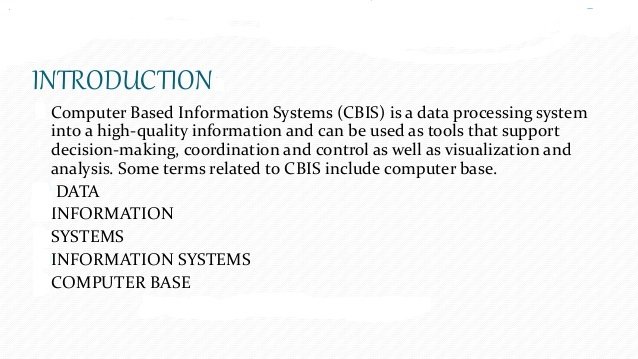A CBIS is an organized integration of hardware and software technologies and human elements designed to produce timely, integrated, accurate and useful information for decision making purposes.
Computer Based Information System is essentially an IS using computer technology to carry out some or all of its planned tasks. The basic components of computer based information system are:
- Hardware: These are the devices like the monitor, processor, printer and keyboard, all of which work together to accept, process, show data and information, hardware and software
- Software: The programs that allow the hardware to process the data.
- Databases: The gathering of associated files or tables containing related data.
- Networks: A connecting system that allows diverse computers to distribute resources.
- Procedures: The commands for combining the components above to process information and produce the preferred output.

Advantages of Computer-Based Information Systems
Compute-based information systems have been in widespread use since the 1990s in industry, non-profit organizations and government agencies. These systems provide fast, centralized access to databases of personnel information, reference reading, best practices and on-the-job training, and are easily customizable to meet an organization’s needs. With the Internet and technology boom of the early 21st century, use of computer-based information networks is growing faster each year.
- Data Centrality
Access to data via a computer network information system is central, providing a “one-stop” location to find and access pertinent computer data. Most large-scale businesses and organizations use some sort of central database to manage user information, manage advertisement lists, store product information and keep track of orders. Examples of central database solutions are MySQL, PostgreSQL or Microsoft SQL database solutions, coupled with custom software which provides user interfaces.
- Information Coverage
Central information systems provide organizations with the advantages of having large amounts of data, covering many different fields, all accessible via a central source. Information coverage is a huge advantage for any organization, because having vast amounts of useful data from every different department streamlines access and increases productivity. For users, having access to a networked information system is analogous to having a digital library of shared knowledge. Recent developments in database information systems link company information access with larger databases of academic and professional research, such as Google Scholar, to provide even more information capability to personnel.
- Access Efficiency
Efficiency of access is a crucial advantage to networked information systems over more traditional information management systems, such as paper cataloging and filing. Computer-based information systems catalog and file documents in a set logical way, making data access very efficient and fast. Data can be manually categorized, and filters created to automatically file documents that match certain patterns. This increases employee productivity time by allowing workers to focus more on the task at hand rather than filing paperwork.
- Extensibility
Computer-based information systems are completely extensible and customizable to an organization’s needs. Upon installation, customized computer information systems use configuration files that are tailor-made to an organization’s needs to file and categorize data. Computer software engineers frequently design custom database interfaces and information storage/recovery systems for enterprise clients. As a company grows, modifications and additions to this filing configuration allow easy extensibility. Computer information systems are not limited in scale or possibility. They are uniquely designed for maximum organizational benefit for each customer.
One thought on “Computer Based Information System”